#cw: death penalty
Text
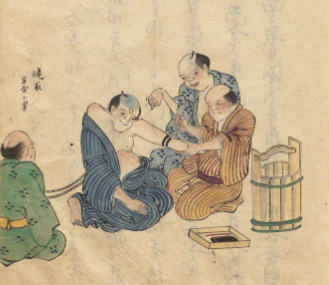
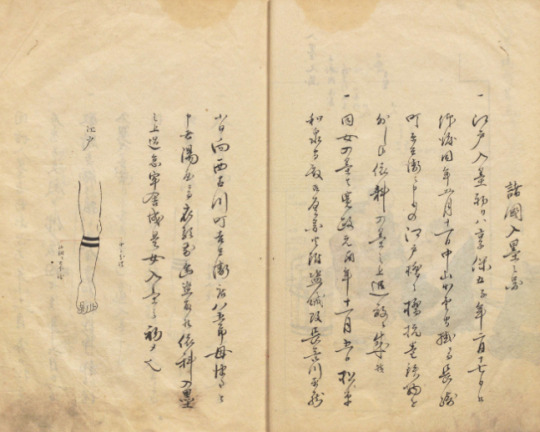
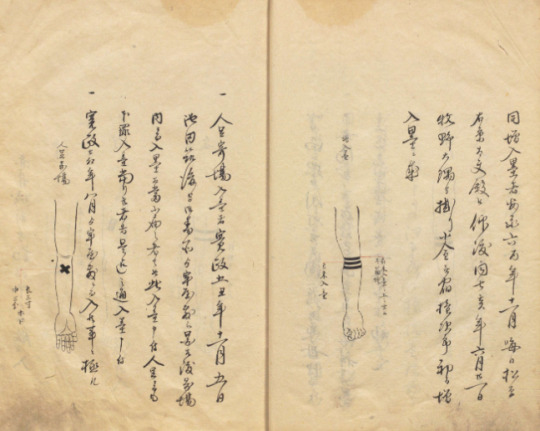

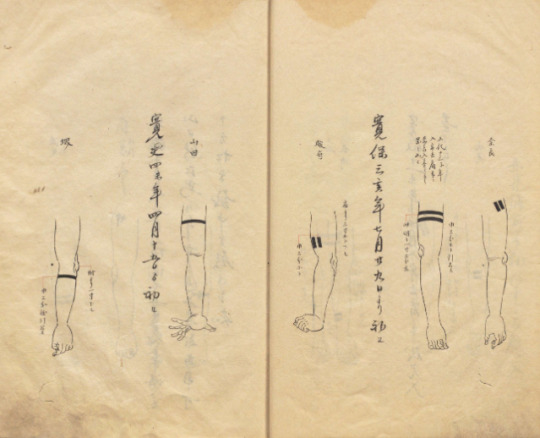
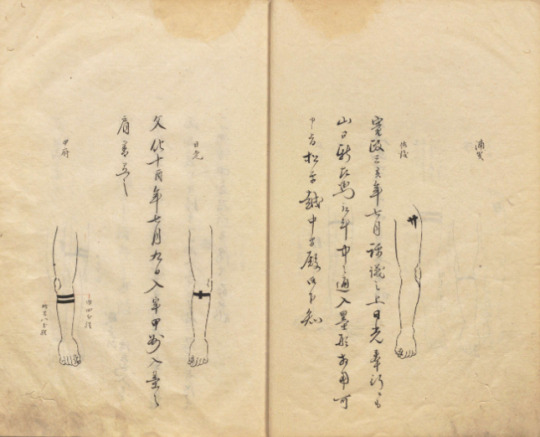
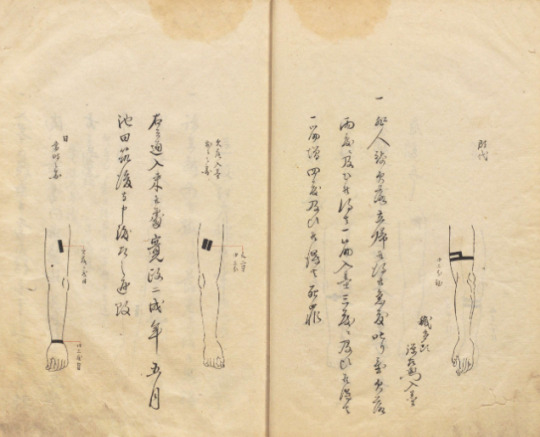
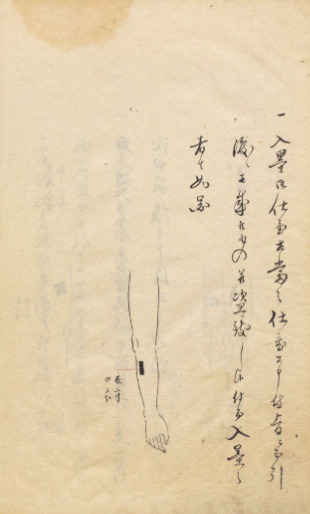
Irezumi kei (tattoo penalty) as depicted in the [徳鄰厳秘録 - Tokuringenbiroku], a kind of penalty instruction book compiled in 1814, digitalized by the National Archives of Japan.
CW for this post about Edo period judiciary => mentions of physical punishment, torture, death penalty (text only, no details, no graphic illustrations) . The irezumikei pages above are p.19 to 25.
I won't reproduced the illustrations here, but the Tokuringenbiroku book also presents other Edo period "punishments" and death penalties, like different types of goumon (torture), gokumon (decapitation and exposure of the head to public view), kakei (stake), haritsuke (crucifixion), or tameshigiri (sword cut testing, here on executed convict corpse).
Please proceed to the full book according to your sensibilities!
Back to irezumi kei : the markings of character Akaza (from Kimetsu no Yaiba/Demon's Slayer) are directly inspired by those, same for Mugen in Samurai Champloo for example:

After Tokugawa Yoshimune's reforms abolished bloodier punishments (nose or ear cutting) for lesser crimes (like theft, gambling or fraud), irezumikei spread, inspired by Chinese bokkei practices.
Yet, zainin (lawbreakers) were also often beaten or whipped (tataki), which could be a "light" sentence or more far extreme one. Women tended to be imprisoned instead.
Punishment tattoos also often went alongside tokorobarai (banishment), which had several levels depending on the crime. You could be banished to a remote island, just away from your city, or forbidden to enter a certain perimeter.
Exile is why different areas had different marks, placed on the arms or faces, easily identifying the person as a criminal convicted in another region.
Number of lines or dots were often used to symbolize repeated offences (pic below source). Most of the times, getting 3+ irezumikei could grant you death penalty.
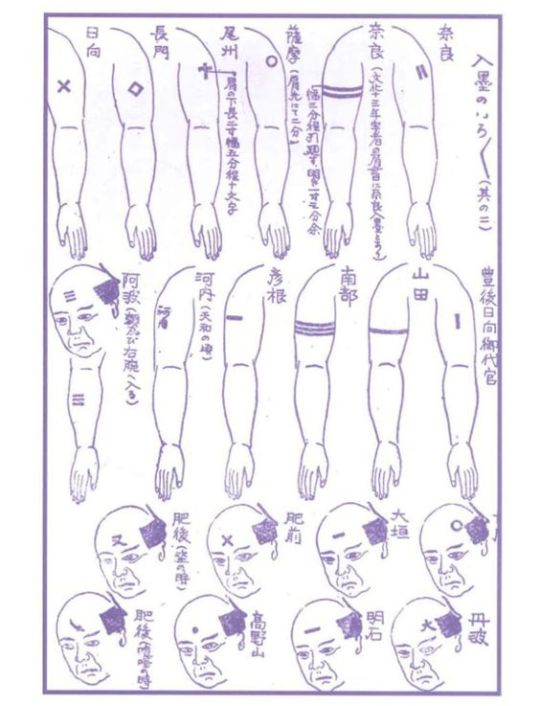
Irezumikei maybe be why criminals came to use extravagant tattoos, as to cover their infamous marks, leading to the yakuza association with body ink.
Yet, other strata of population also favored figurative tattoos, so the link between criminals and tattoing in Edo period is not self-evident.
Some shapes of -sode (sleeve part of a tattoo) for example left arm interior bare, maybe to prove then that no armband tattoo was hidden underneath a bigger design.
#japan#japanese history#Edo period#crimes#judiciary#theft#fraud#cw: physical punishment#cw: torture#cw: death penalty#irezumi#Japanese tattoo#horimono#irezumikei#criminal tattoo#yakuza#tokorobarai#tataki#gokumon#kakei#haritsuke#tameshigiri#徳鄰厳秘録#Tokuringenbiroku
305 notes
·
View notes
Text
It seems my experiment in actually writing something substantive and not just screaming about bangs was well-received! I will insist that it is a fluke for a while, just to keep up appearances, but truly, thank you all. Let's move forward with the first season of LWT!
Last Lee Tonight
(wherein we talk about shirts and the death penalty, not in that order)
Season One, Episode Two

(original air date: 5/4/2014)
Major topic covered: Capital punishment, Brunei
Trigger warnings for discussion of the death penalty and botched executions; homophobia
"As you know, our show is dedicated to covering the biggest news of the week, whatever that news may be. We have a long, proud, one week history of doing that."
As much as the last episode of LWT covered was a time capsule shooting us straight back to 2014, this episode proves that time is basically a flat circle. John opens this episode talking about Russia invading Ukraine, and how the US and allies are going to stop this threat by... imposing sanctions. (Thank God we grew more committed to actually helping Ukraine in our current timeline, Republican agents be damned.) These sanctions, both in the moment and looking at this from the future, clearly didn't do much.
Already the pacing of the show is growing slower, to LWT's benefit - the Ukraine segment, despite being about two minutes, hits more concrete satirical points and feels more put-together than everything from the first segment of episode one.
It seamlessly transitions to what the US was more interested in than the potential fall of Ukraine, the White House Correspondents Dinner. John hates the idea of it and shows clips where George Condon of the White House Correspondents Association talks about how its purpose has completely diverged from its intention in its charter... but he can't show it because the White House lost it. Let's use this space to remind people of the time Stephen Colbert fucking ethered George W. Bush at the Correspondents Dinner in 2006, as I inherently believe that ethering presidents was the entire point of the Correspondents Dinner as laid out in that charter. You can't convince me otherwise.
"And Now This" gives us our first "local newscasters get really excited about a dumb thing" clip package, this one for Star Wars Day. There are so many wide-ranging ways to sound like you're being held hostage while saying "may the fourth be with you"! (The lady who said 'I actually speak droid' painfully reminded me of child me, who said that maybe three million times. As I've said many times, I was a deeply weird child.)
Unlike last episode, episode two isn't structured like an ersatz version of The Daily Show, and instead is beginning to resemble the LWT format of the current day. I genuinely thought it took longer for the show to morph into that, but no, the staff collectively went "fuck it, let's spend fifteen minutes talking about the death penalty and see where it takes us". Good move staff!
John even acknowledges that it's a potentially awful choice to make for a show's second episode, particularly because he is a comedy show. (HAHAHAHAHAHAHA oh John. Poor sweet innocent past John. LWT, a comedy. Haaaaaaaaaaaaaaaa)
youtube
The kick-off for this segment is news in Oklahoma of an inmate dying after a botched execution. John isn't sure he wants to talk about it, President Obama doesn't want to talk about it, do any of us want to talk about this? But we're talking about it.
Despite the show moving more towards its current iteration, there is still that early-series weirdness to it all. For starters, the idea of John not wanting to talk about the death penalty, when he went on to be the subject of a SLAPP suit because of his show, has routinely discussed abortion and trans rights (the two things most likely to get people screaming at you in my personal experience), and is just generally is plumbing the depths of governmental and social misery every week, is a bit comical. Additionally, the segment officially opens with an extremely didactic "what is the death penalty and what are the arguments for and against" mini-monologue that seems designed to guide audiences through this new type of late-night show. John pulls off being a teacher well, but this sounds like an actual high school teacher trying to introduce a topic they know is gonna be a shitshow.
It is nice to know that the baseline for the death penalty according to the first clip is that we shouldn't execute innocent people. Bold statement.
John also sells the idea that he is an outsider to this topic since he is British. This is another thing dispensed with quickly on the show - he's an American and generally defines himself as such unless it's funnier for a joke - and I honestly didn't expect it to crop up in LWT at all. I'm guessing he brings it up so he can talk about British torture devices, a rich vein of violent nonsense he's loved his entire career, but point still stands. Genuinely shocked he didn't talk about burning Catholics at the stake. Someone must have stopped him in the writer's room from slipping his favorite joke in there.
I don't want to get too in-detail about the factual arguments for any given subject while doing this project, unless I feel like I have interesting additional insight from my own life or a clip shown is ridiculous enough to note it. In any case, this segment is a well-done, high-level view, from my understanding, of the basics of the death penalty argument in the US.
On that level, it is sadly hilarious that John makes a joke that the death penalty is a great deterrent to fishing without a license, since he has done multiple segments since this showing that no, it's really not.
The way this segment ends is also somewhat off, in that it feels like there should be something stronger tying it together. John offers a hypothetical about a guilty person committing a heinous crime and the family of the victims wanting their death - what would you do in that situation? And instead of a clip or a more rigorous examination of that hypothetical, John offers that his opinion is still that the death penalty isn't a good recourse, and that the opinion of you at home might be different, who wants to see hamsters eating burritos? It's... weird. And it's weird because I am looking at this from ten years in the future, recalling John begging England to not vote for Brexit, hearing and seeing the entire last video clip about forced family separation at the border echoing in my head. I can't expect past John to be at where current John is now, and yet, that still colors how I look at this first stab (...ugh bad wording) at a longform LWT segment.
The death penalty segment gives way to something seemingly ripped straight from The Colbert Report, "Other Countries' Presidents of the United States". Truly, this reminds me so much of "Better Know a District". This segment focuses on Francois Hollande of France, namely his complicated and gross history with women and how that somehow made him more popular with voters.
We move on to Brunei, which is a country. (Literal words from the show here, I'm not that ignorant.) Important note, he does not try to fool the audience into thinking Brunei is a country you think about so seldomly that you haven't realized that this ISN'T Brunei, it's actually a pockmark on my face. Namely, Brunei is starting an "experiment with Sharia law" that involves implementing the death penalty for homosexuality. John highlights the hypocrisy of the leadership's turn given their ostentatious wealth and lax morals. Again, pretty solid overview of the situation and the international blind eye being taken there, and good on John for criticising Saudi Arabia consistently.
Finally, our last "And Now This" is people falling asleep behind politicians. I adore this kind of dumb shit. The guy behind Biden is a treasure.
Random notes:
Lee obviously focuses on important things corner: Red is John's color and I will die on this hill. Red shirted John Oliver is my goddamn kryptonite. 10/10.
Gdi Lee you're getting old: I bought Stephen Colbert's Correspondents Dinner speech on iTunes so I could listen to it on my way to classes in college. WHAT A SENTENCE!
Apparently they did an interview with Simon Ostrovsky from Vice News that was cut for time. Not only have I never watched this, why were they cutting things for time on HBO? (I will make a separate post about this interview because I genuinely have no idea what it's about and forgot it existed.)
Filmed during the same episode is a Web Exclusive of John getting a case full of Pom Wonderful from the Pom people, and them telling him, in veiled language, to shove it up his ass. He is clearly delighted by the letter. "Dear John, What fun."
youtube
#john oliver#last week tonight#last week tonight with john oliver#last lee tonight#cw: death#cw: death penalty#cw: homophobia#Youtube
10 notes
·
View notes
Text
pro-marijuana anti- capital punishment politician trying to appeal to gen z like "abolish stoning women 😭🙏 let women get stoned ☘️🤪"
110 notes
·
View notes
Text
In 2021, my grandfather was murdered. The state calls it manslaughter, but it was murder. Because I live in a death penalty state, I am more happy than not with that definition. I do not want his killers to die by the hand of the state or any hand at all. I have forgiven them.
I am a person with traumatic grief. It may even be classed as post traumatic stress when I go see a psychologist this month. Nevertheless, I am a staunch opposer of the death penalty.
As part of being a Christian, as well as a Quaker, I am called to forgive. Not a day goes by that I don't think about it. Not a day goes by that I don't forgive them all over again. I love them as my fellow man.
#progressive christianity#christian#death penalty#anti death penalty#quaker#quakerism#society of friends#prison abolition#abolish prisons#prison reform#tw death#cw death#tw murder#cw murder
65 notes
·
View notes
Photo


I... I mean, we love you very much. So come home soon. Let’s hug tight.
#sila turkoglu#sıla türkoğlu#kizilcik serbeti#kızılcık Şerbeti#turkish fc#turkish dizi#turkishedit#edit*#*#( fc. )#( fc. ) favorites#pregnancy cw#doga is so cute. i hope her husband fucking chokes and dies. :)#cheating on your pregnant wife should be automatic Death Penalty
124 notes
·
View notes
Text
CW Albert Arenas
A win doesn't get you good treatment ☝️😔
#yes i do think *cw albert arenas* is hilarious#tho i dont rlly have beef w him hes just some guy#rip oncu i think if ur napping in a car n someone interrupts u they deserve death penalty#why yes i did once almost suffocate myself taking a nap in a stationary car in the summer w the windows n doors closed whos asking?#car naps r absolutely unmatched#til my tailbone starts hurting#moto3#moto2#albert arenas#deniz oncu
25 notes
·
View notes
Note
I might kin from Garten of Banban. I think this crime should carry the death penalty, so I can be put out of my misery /j
🖨
7 notes
·
View notes
Text
Once again putting forth my third-way proposal that we begin implementing capital punishment solely through suitless space walks. This would put us in a double bind of positive outcomes; either executions drop to nothing because it’s prohibitively expensive to keep training death row inmates as astronauts, or the wholesome tenacity of the American killing spirit will give the space program the kick in the pants it sorely needs absent a relevant military opponent. Will there be be negative externalities, you ask? Sure. We’ll see a sharp uptick in the most brutal murders imaginable, committed by individuals so determined to achieve sweet momentary communion with the one true void that they’ll pay any moral cost. But let’s not kid ourselves; all progressive policies have drawbacks. The only true sin is to elide them when the concept is brought to table.
84 notes
·
View notes
Text
Im here today to talk to you about one of my special interests;
Señor Danny Trejó

This man has lived such a life at age 79; and is still kicking, but I think people don’t really appreciate all this man has been through to be who he is. I genuinely believe his biopic needs to be made bc oh my goodness.
CW: drug usage, incarceration experiences, tough home life, murder, stabbing, death penalty, violence (feel free to lmk more and I’ll add as pointed out)
Also to note; this is a historical summary. Aka the facts with as little of my opinion as I can manage (while considering that I do have a bias), I do not condone the violent acts mentioned. That being said I do sympathize with many actions being a product of circumstance and that this is a man trying to own his past while using his present to make a better future for himself and others. And THAT is why I respect the hell out of him
Ok let’s start this; spoiler alert I look like

By the end
Ok so Im gonna have to categorize this baby; a note, most of this is from his Wikipedia page and subsequent cited sources

Personal

-was born in (1944) as the child of an extramarital affair; his mothers husband was away fighting in WW2 at the time
-He’s been a fan of the LA Rams since their early days (1946) and some of his earliest memories are from sneaking into games as a child
-he fled LA with his family to Texas as a small child bc his father was wanted for stabbing someone. His father turned himself in a year after moving back to LA
-he purchased his childhood home and as of his 2020 biopic, still intermittently lives in it.
-he completed his high school diploma during his stay at Soledad correctional facility (likely during his time in solitary)
-among his many jobs between prison and film; Trejo helped construct the Cinerama Dome in California (now where many of his films have been screened at today) with a construction company as a labourer, a gardener and part time owner of a lawn company
-Trejo has been quoted to still have fears that his life is all just been a dream and that ‘hell wake up in prison with someone urging him to “go get some chow”
-Trejo has been a contributor to several books relating to prison life
-trejo published a cookbook in 2020 and his memoir in 2021
-As of 2020 Trejo owns 8 restaurants; including a taco restaurant, a cantina and a coffee and donut shop. His rainbow cauliflower tacos made the LA times fav recipes of 2017
-He has been married and divorced 4x with 3 children (however he helped raise 2 additional children with his second wife)
-Trejo is a registered Democrat
-battled liver cancer in 2010, moved to be closer to his mom in 2011. She passed while filming the Muppets most wanted in 2013. Although sad, Trejo recalls he didn’t truly break down until Kermit offered his apologies in character (due to his macho personality)
-In 2019 Trejo witnessed a car accident and helped rescue a small ychild from that very wreckage (trapped in the car seat in an overturned SUV)

Prison

-was first arrested at age 10, first incarcerated at age 12 at Eastlake Juvenile Hall
-was in various prisons within the California prison system from 1956-1969 (conflicting accounts say one term may have been till ‘72)
-notable stints include; three years at Camp Glen Rockey in San Dimas for stabbing a sailor in the face with broken glass, a stint in Los Angeles County in 1961 where he met Charles Manson (who Trejo describes as a “dirty, greasy, scrawny white boy” who was an allegedly talented hypnotist), Soledad in 1968 where he hit a guard with a rock during a prison riot on Cinco de Mayo. Due to this he was sent to solitary confinement and faced capital charges and the death penalty. He also completed the 12 step program at this time.
-His most memorable stint was in San Quentin in 1966; his heron use was exacerbated here. Here he was a debt collector and drug dealer; often engaging and witnessing acts of violence and occasional murder. He also picked up boxing in this stint and became both a champion of the lightweight and welterweight divisions throughout his other prison experiences.
-his final prison stint was five years of a ten year sentence, most commonly believed to have ended in 1969 (aged 25)
-he was known as the gossip queen of his cell block in several prisons
Drug Usage and Recovery

- Trejo had been using Marijuana since age 8, heron by age 12, and cocaine by age 13; all introduced by his uncle Gilbert
-Trejo overdosed on first heron fix (also under his uncle’s supervision)
- participated in his first drug deal at age 7
-completed the 12 step program during his time in solitary at Soledad. He has been quoted being sober since completing this program, and is celebrating 54 years in recovery
- Trejo became a substance abuse counsellor in 1973, and is still actively working to help substance abuse cases today
-in the 1980s Trejo worked in Western Pacific Med Corp, assisting with the establishment and operation of sober living houses. He also lived in the houses at this time
-He was called to help assist with the cocaine usage amongst teenagers on the set of Runaway Train (1985)
-Trejos work as an actor was meant to help further his work as a rehabilitation counsellor and he claimed it helped him as clients would recognize him as an actor
-While filming scenes at San Quentin for Blood In, Blood Out; trejo helped a prisoner (Mario Castillo) through the 12 step program and remained in touch after his release. Today him and Mario remain great friends and both speak around the country in both juvenile detention centres as well as rehabilitation centres about their experiences
Film
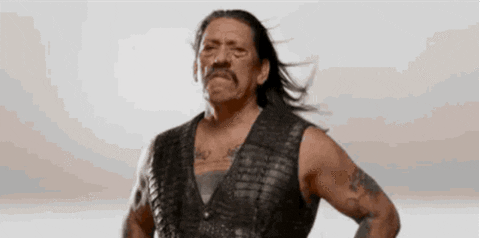
-his character Machete was created FOR the Spy Kids film
-the creator of the Spy Kids franchise is his second cousin
-Danny originally got into acting after meeting a boy in a sober living house who explained he worked a day job as an extra to make 50$ a day (in 1980); between the “easy money”, availability with his schedule and publicity he could provide to the Western Living House Org, Danny decided to find an agent for background rolls
-After being asked to help with cocaine issues on the set of Runaway Train, Trejo was recognized by the screenplay writer, Edward Bunker. Bunker has been a fellow inmate with Trejo in San Quentin and was also a fan of his boxing work. Bunker helped hire Trejo as a boxing trainer on the film and negotiated Trejos pay to be closer to ~$330 a day, due to his additional help on set and general knowledge/experience
-Bunker also helped land Trejo a role as a background actor in the prison scenes in Runaway
-Penitentiary 3 (1987) was his first billed role, during which he met one of the members of the Galbino crime family (one of the 5 mafia families in New York)
-in 1991 Trejo turned down a role offered by Edward James Olmos due to a call from the don of the Mexican Mafia advising him to take a role in Blood In, Blood Out (1993) instead
-During the filming of Blood In, Blood Out; Trejo experienced PTSD while filming his scenes in San Quentin. Especially when filming the scenes in C550, his previous cell from his time incarnated there
-Whike filming Anaconda (1997), Trejo was able to negotiate a higher salary when filming in Venezuela. As Trejo enjoyed leaving the hotel to socialize in his off time…during a possible coup. A particular incident with a group of teenagers with AK-47s brandished at Trejo over his combat boots, helped Trejo negotiate the higher salary to REMAIN at the hotel in his down time
-Trejo contracted Hepatitis C shortly before filming Spy Kids and concluded treatment and recovery just before its premiere (however had gotten so I’ll that his cast noticed his weight loss and demeanour in a different project filmed during spy kids post production)
-Trejo produced his first film in 2014
-To date Trejo has 445 acting credits on IMDB (between 1985-2023) and 84 on screen deaths (12 TV, 72 movies) according to cinemorge (+4 are music video deaths, +1 video game death)
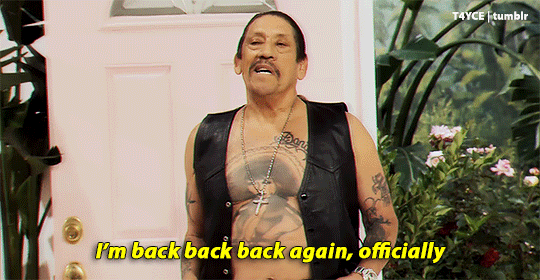
-in total that would make Trejos risk of onscreen death per project roughly 20% per project (89/445)
In Conclusion

#danny Trejo#in conclusion this is the celeb I would have dinner with#prison#anecdote#san quentin#biography#life summary#long post#but in all seriousness#where is the biopic Hollywood#cw drugs#cw#drugs#murder#violence#drug usage#death penalty#stabbing#feel free to let me know of any more and I’ll put them here
10 notes
·
View notes
Text
trigger warning: fire, burning
(also maybe a sewerslide mention?)
[this post relates to the last post]

the burning of the witch
#art#illustration#my sona#sona#artist sona#cw burning#cw fire#fire tw#execution#capital punishment#death penalty#death tw#notes:#my sona has her beret and hair bows off#her hair is also down#i'm also really proud of how i drew the clothing burns :)#she has a thorn crown on#vent#tw vent#vent post#cw sui implied
2 notes
·
View notes
Text
Also that death penalty was inspired by seeing the reaction to the murder of a tech executive in San Fransisco, Bob Lee, where all of San Fransisco's VC & tech types took three seconds to unleash their latent fascist, raving about how it had to be a drug-addicted homeless person and the streets must be purged of undesirables and that liberal DAs have blood on their hands and how they should stage public hangings since "the lives of five hung drug dealers are worth the lives of everyone else"
Anyway it turns out Bob Lee was likely murdered by a fellow tech executive he knew, and all the people who rushed to advocate for mass state violence seem bound to never mention it again or going "yeah in this case it wasn't, BUT maybe next time". California is being invaded, say the invaders to the people they displaced
13 notes
·
View notes
Link
Is the death penalty—judicial or extra-judicial—an effective deterrent of the drug epidemic? Malaysians and policymakers are unable to agree on whether some crimes, such as drug trafficking without violence, should be penalised by death. The Malaysian government has stated that the mandatory death sentence, which is statutory for certain offences, including nonviolent drug trafficking convictions, is likely to be abolished. This would give judges the discretion to impose a different punishment for the 23 crimes that carry the death sentence. Many ASEAN nations are wrestling with the question of whether or not capital punishment is effective.
In the Philippines the number of civilians killed in the drug war from July 2016 to March 2019 “appears to be between 12,000 and 30,000.” Former President, Rodrigo Duterte named 44 mayors, vice mayors and other officials in May 2019 as being “narco politicians”. But when his son and Davao’s Vice Mayor, Paolo Duterte, was accused of aiding and abetting a seized shipment of $125 million worth of narcotics from China for the Philippines market, Duterte senior was less enthusiastic to carry his extrajudicial killings. On the other hand, also in 2019, the police executed two former governors, both of whom had been designated as “narco politicians” on Duterte’s watch list.
The Malaysian case is no different. Tan Sris and Datuks (titles conferred to dignitaries by Malaysian heads of state) lead the drug cartels, at least in the case of the RM 2.4 billion (0.55 billion USD) confiscated from the North Butterworth Container Terminal (NBCT) in September 2019. These Malaysian drug lords are able to attain these titles because they too were probably able to hide the fact that they are laundering money by, among other things, running pawn shops, shipping companies, and hotels. The continuous arrests of policemen involved in drug dealing and consumption shows a symbiotic relationship between law enforcement and the drug related crime networks. Malaysia has to play a more important role in going after the drug lords because, as mentioned by the Inspector General of Police (IGP) of the Royal Malaysian Police (RMP), the country is a transit point for drugs being sent to other countries.
The thinning of the grey lines between the executive and drug lords by the likes of Myanmar’s Lo Hsing Han further exacerbates the problem. In the 1960s, he was given permission to traffic opium and heroin in exchange for commanding a local militia formed by then-dictator Ne Win to battle communists on the country’s borders with China. Meanwhile, Lo sided with the insurgents during the next decade, and he was captured in Thailand in 1973 and condemned to death for treason. His sentence was eventually reduced to life in prison, and he was released under a general amnesty in 1980. Thus, started the second half of his career, during which he was reported to continue his heroin business, using poor farmers from Myanmar’s Shan state and northern Thailand to cultivate opium for him. When he turned around and decided to disassociate himself from his life of crime He found receptive partners in Thailand’s business communities, multi-national corporations and governments, notably in Malaysia, Hong Kong, and Singapore. One such example is Asia World Co Ltd, a major infrastructure conglomerate in Myanmar partially owned by Lo’s son, Steven Law, with which the Singapore government had a joint venture. That venture has been blacklisted by the US Office of Foreign Assets Control (OFAC).
Evidently, there is a transnational criminal network that controls an extensive operation involving air cargo and shipping services which send drugs to Indonesia, Taiwan, Hong Kong, and Australia. The 2017 arrest of Xaysana Keopimpha – a Lao dubbed the “ASEAN drug lord”, exposed a major drug ring that had links to insurgents in Thailand’s Deep South.
While most ASEAN nations turn a blind eye to drug lords and cartels, they are keener to execute naive teenage drug mules. Nagaenthran Dharmalingam, for example, was a Malaysian with learning disabilities who was convicted of narcotics trafficking in 2010 and whose case drew international attention. He was recently executed at Singapore’s Changi prison.
The question is, why are countries like Malaysia, Singapore and the Philippines are so quick to impose death penalties and extrajudicial killings for drug mules and drug peddlers, but not as effective in taking action against the drug lords?
In Singapore there is an over-representation of Malays condemned to death. Between 2010 and 2021, 50 of the 77 persons condemned to death were Malays, 15 Indians, 10 Chinese, and two others. Due to a lack of transparency, we may extrapolate from publicly accessible statistics that Indian men are overrepresented in Malaysian prisons and are particularly vulnerable to custodial mortality. In the Philippines, the policy of executing individuals without trial, implemented by Duterte, disproportionately harmed the poor.
The fact that dirty money needs to be cleaned to make legitimate “real world” purchases, provides opportunities for law enforcement agencies in ASEAN to collectively monitor drug lords and drug traffickers. Despite the fact that drug trafficking syndicates are always inventing new strategies to conceal their operations, the police have been successful in locating and arresting these drug lords. They have been known to operate pawn shops, shipping companies, hotels and even bundle clothing stores. Additionally, the drug trafficking routes and ‘rat lanes’ along the border states such as the Southern Thailand – Malaysia requires joint efforts and efficient patrolling. Drug mule trafficking can only be eliminated if politicians and law enforcement agencies work together to combat the web of organised crime and bring drug lords to justice. While the law says that drug mules must be executed, drug lords dine with legislators and discuss capitalist methods to exploit people and launder money.
41 notes
·
View notes
Text
i dont really caare when ads are marketed to niche demographics except when i see ads marketing to near/divorcees. thats the funniest shit in the world. there's nothing better than an advertiser looking you in the eye and telling you that this 4wd will fix the broken relationship with the wife i dont have.
#cw capitalism#theyre so bad your honour and they keep playing it#they keep playing the relationship fixer car ad please help#im seeking the death penalty
2 notes
·
View notes
Note
What are you reasoning for being against the death penalty? /g
Aside from the fact that approximately 4.1% of people sentenced to death in the United States are innocent?
The death penalty literally does not work as a deterrent. People still commit crimes that are punishable by death all the time.
Also, POC are disproportionately targeted by police, the prison system, and the death penalty. What percentage of people on death row right now are black? 41%. Black people in the United States make up 54% of wrongful convictions.
Mentally ill people are also targeted disproportionately. Especially mentally ill POC, and especially those who experience psychosis.
The death penalty also proves that prison in North America is about punishment and not rehabilitation. If you kill someone to drive home the point that killing is bad, not only are you a massive hypocrite but that lesson is completely lost on the person because they're dead.
Tldr: the death penalty is just as rooted in racism and hatred as the police system. Too many innocent people are "executed" (murdered) every year, guilty people don't deserve to be killed either.
#execution tw#death penalty tw#murder tw#cw murder#ask to tag#death tw#cw death#cw execution#death penalty cw
20 notes
·
View notes
Note
If you're against both the death penalty and prisons, what would you suggest the punishment be for serial killers and rapists? Community service, anti-poverty measures, rehabilitation in general don't work for some crimes. Or would they be an exception?
When I say I'm against prisons I mean I'm against prisons in the current form- punitive, abusive centres of brutality that aim to "beat" the crime out of people. I'm not against containment of people who are truly dangerous to society, but I also believe that almost anyone can theoretically be rehabilitated.
With a rapist or serial killer, yeah, they need to be in an environment where they don't have access to the general public until they're safe to be out in it. But they don't need to be put in a complex with dozens of other offenders and a few cops and armed guards and be expected to rehabilitate themselves. The solution to this might be found in a middle ground- like a medical facility where people trained in rehabilitative psychology could work with these people, in an environment where they don't have access to things like weapons.
Also, I genuinely believe that in an ideal society, drive to do things like rape and murder would be much lower. Rape is mainly driven by a hypermasculine, patriarchal, and sex-obsessed culture (yes, female rapists do exist, but the third point still applies to them). A culture in which these things are not values would naturally involve less rape. Just imagine if boys were taught to respect girls instead of tease, harass, or treat them as lesser. Murder is often driven for want of some kind of either gain or revenge, or is the result of deep-seated psychological issues.
However, people like petty thieves are not a danger to the people in a society- only the property. It's not inherently dangerous to lose some stuff, and less people would steal anyways if they have the things they need. Someone who steals frequently might have to be involved in some sort of community service to make up for the minor damage done to society, but they certainly don't need to be in jail.
Repeat offender rapists and serial killers I have mixed thoughts on. The issue with the death penalty here is we have not figured out any way to do it remotely humanely on humans.
Again, I'm not as knowledgeable on this subject as I am on some others, so take everything I say with a grain of salt. I hope this answer cleared some things up for you.
[NOTE: I will not be engaging in public discourse on this ask. If you have questions, feel free to give me a DM.]
19 notes
·
View notes
Note
Currently getting closer to my practical exam day and practising my monologue is so fun, especially since it’s my source. Like. “This is a court of justice. You’ll get justice here.” Yes of course she’s going to get justice here, but only for her crimes, and the penalty is death! Haha. Why am I so maniacal about this.
— Lawrence Wargrave (And Then There Were None) #📺🎙️💥
x
#📺🎙️💥#fictionkinfessions#fictionkin#lawrencewargravekin#andthentherewerenonekin#mod party cat#schools cw#death penalty cw
5 notes
·
View notes